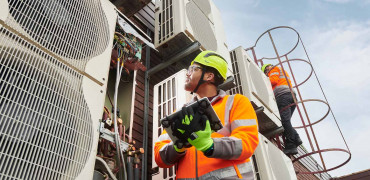Decarbonisation has become a bit of a buzz word recently across the construction industry and it is now used in reference to future-proofing buildings, in line with both legislative requirements and net zero targets.
Anyone involved in heating, ventilation and air conditioning should be well up-to-speed on the nuances of decarbonisation but beyond the core HVAC sector, just how many people are aware of the importance of decarbonisation in helping the UK achieve its legal net zero targets?
If you stop someone in the street and ask ‘What is decarbonisation?’ you are likely to get, at worst blank looks, or at best, a wide variety of confused answers!
This article therefore focuses on the very basics of the issue to help increase understanding.
Decarbonisation is a hot but complex topic
What is decarbonisation?
Decarbonisation is defined as the process of removing or reducing a business’s CO2 emissions to limit the impact of climate change.
But is decarbonisation a significant factor in a business’s blueprint to longevity?
The simple answer is, yes.
Buildings account for over a third of all global energy consumption and emissions according to the International Energy Agency.
This includes the energy used in the construction, operation and heating and cooling of both residential and commercial buildings.
Importance in combating climate change
Climate change refers to the long-term change in the earth’s temperature and weather patterns. This means harsher winters and extreme heat in the summers, which will adversely affect our ecosystem.
But extreme weather conditions are just one effect of climate change. We may have to prepare ourselves for the cost of food and amenities to also rise as agricultural land is lost to desert or floods, and supply chains are disrupted.
Reducing CO2 and greenhouse gases being released into the atmosphere, will help to limit the extreme effects of climate change.
That’s where decarbonisation comes into play.
How does decarbonisation work?
As mentioned before, decarbonisation means limiting the impact of climate change by removing or reducing the amount of CO2 a business is releasing into the atmosphere.
These reductions can often be made by switching to power from sustainable energy sources and technologies, such as changing from coal-fired power stations to renewable sources, such as solar, wind or hydroelectric power.
In addition to switching power suppliers, businesses can also reduce their emissions by adding solar panels to generate their own electricity, and by removing gas from their sites and introducing sustainable technologies, such as heat pumps.
Key methods and technologies involved in decarbonisation
- Renewable energy sources (solar, wind, hydro, etc.)
Renewable energy means energy obtained from natural sources that replenish at a rate higher than consumed. These plentiful resources are paramount in helping achieve the UK’s net zero targets.
Solar power is becoming increasingly popular in the built environment with many new build developments adopting the renewable source as a new standard during construction. Solar works by harvesting the sun’s energy using photovoltaic panels that convert this energy into electric power.
Wind power is used to turn the blades of a wind turbine around a rotor which then spins a generator, creating electricity. Wind power plants or wind farms can be found in several places across the UK which are known for their frequent high winds, both on-shore and off-shore.
Hydroelectric power plants harvest the kinetic energy of fast-flowing water. This energy is then sent to turbines and generators that convert it into electricity before sending it to the grid to power businesses and homes across the UK.
All these renewable energy sources are very efficient and play a key role in decarbonising the electricity grid that powers the built environment.
- Energy efficiency and conservation measures
Put simply, energy efficiency is about using the least energy possible to perform the same task and produce the same result.
An example would be an energy-efficient building using less energy to heat and cool occupants by using renewable technologies compared to a building using a traditional gas boiler.
Energy conservation focuses on the actions of the building occupier that are needed to reduce energy consumption.
Both go hand-in-hand to help achieve the common goal of energy reduction and decarbonisation.
One solution to energy efficiency can be installing a heat pump into a building, replacing the old gas-boiler system.
The energy conservation measure would be reducing the temperature in certain rooms when they not in use.
Benefits and how to take advantage of decarbonisation
- Adopting renewable energy solutions
As a manufacturer of renewable and energy efficient equipment, you might expect us to promote heat pumps as THE solution and, whilst we have reached the end of gas as the dominant form of heating, we also recognise that not all homes or businesses can make a switch immediately.
Whilst changing to renewable heat pumps presents as a significant opportunity to reduce energy consumption and save on running costs, there are simple things any homeowner or business can do to reduce carbon emissions while planning such a switch.
The first thing to do is to review what you have and make sure it is serviced and performing to its best ability. Getting your gas boiler checked will ensure it delivers the heat you need using the minimum energy possible – We call this being Lean.
Next is finding ways to reduce energy even more, with the most simple being to turn down the thermostat by a degree or two – This is the Mean phase.
Then you can look at planning for a replacement, giving you time to see what incentives or support there might be out there – Time to move to the Green phase, and in addition to looking at the equipment you use within your building, it’s also worth looking at where your energy comes from and how ‘green’ your supplier is.
- Investing in clean energy industries
By investing into clean energy, such as solar panels, wind turbines or even hydroelectric power, businesses could generate their own electricity, leading to substantial savings over time.
Purchasing your own wind turbine may seem far-fetched for many businesses in the UK but there are local communities that are looking into this.
For others though, making the switch to a renewable energy provider will greatly impact your success in decarbonising your building.
- Supporting policies promoting decarbonisation (Social housing decarbonisation fund)
The public sector will require support from government to decarbonise and this is where key policies and legislative schemes are helping to reduce carbon in public buildings to meet net zero targets by 2050.
The LCSF (Low Carbon Skills Fund) and PSDS (Public Sector Decarbonisation Fund) are part of the Department for Business, Energy and Industrial Strategy (BEIS) programmes aiming to deliver £1.425 billion of grants between 2022 and 2025.
The aim is for the public sector to lead by example on low-carbon heating, and to drive the market for low-carbon technologies. These schemes are managed by Salix Finance, which is why they’re often referred to as ‘Salix funding’.
The residential sector is also moving in the right direction with the Social Housing Decarbonisation Fund, which is supporting energy efficient measures such as air-source heat pumps being installed across social homes in England. These will deliver warm, energy-efficient homes whilst also reducing carbon-emissions and home utility bills.
Private households can access the Boiler Update Scheme, which the Government recently increased to £7,500.
Case Studies and how we can help
- Decarbonising the Civic Centre
At Mitsubishi Electric, we have been working with several public sector clients to help them reduce carbon by introducing the latest low-carbon heating systems into their buildings.
The most recent example sees Salford City Council upgrade the heating in its Civic Centre which has helped reduce the building’s carbon footprint by 70 tonnes, or around 54%.
The project saw the removal of the gas and oil boiler systems and their replacement with 11 CAHV air source heat pumps, which can deliver water at flow temperatures of 25 to 70 degrees Centigrade.
Decarbonisation is a hot but complex topic. Mitsubishi Electric can help businesses establish the right solutions tailored to each unique specification, keeping carbon reduction at the heart of design.
If you have a specific project in mind and would like to discuss it with one of the team, please do get in touch.
Katie Mathers is Marketing Co-ordinator



